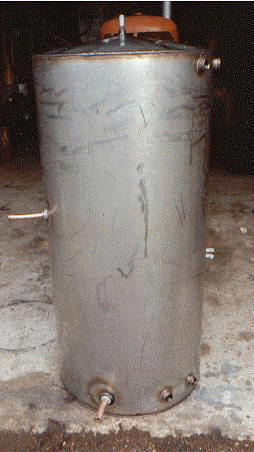
Search
The Renewable Energy site for Do-It-Yourselfers
Two PV Pumped Closed Loop Solar
Water Heating Systems
This page covers two closed loop
solar water heating systems that use a PV powered pump to circulate the working
fluid. Both systems have been in operation for quite a while and work
well.
The first is Doug's own system, and
the 2nd is a system that Doug helped friend Bob install.
Doug's system
Bob's system
Doug's DIY Solar
Water Heater
This Photovoltaic (PV) pumped hot water system has been working well, with
no maintenance, for years on my house. I am now well past the point where
the money I invested in the solar water heater equals the money I would have
spent on electricity to heat water. Most of the year, we have more free hot
water than we can use. Consider the fact that in the next five to eight years
you are going to pay the cost of a solar water heater, whether you buy one or
not. I kept costs down by doing all of the work myself, and buying a used
collector panel, but still created a long lasting, efficient, high quality
system.
I started by looking in the yellow pages under "Solar", and found a plumber in
the nearest large city, with spare collector panels. I bought a 3`x13` aluminum
collector with copper tubing and tempered glass cover for $100, guaranteed not
to leak, but I tested it first, anyway. Assuming the collector needs to be
freeze protected, a non-toxic antifreeze, usually propylene glycol, is pumped
through the collector, to the heat exchanger tank.
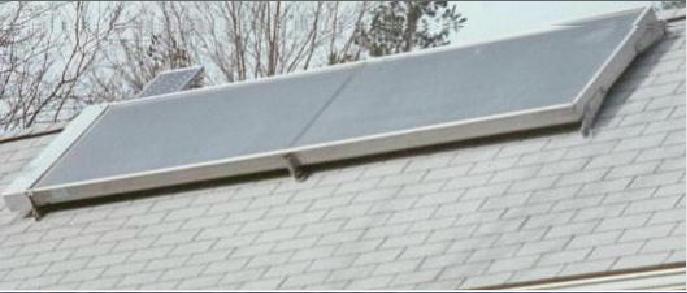
Collector mounted on the roof. PV panel to drive circulator pump is
visible at the upper left.
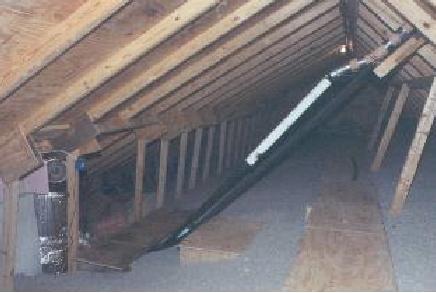
Solar water heater plumbing running through the attic.
The 12 volt DC circulator is mounted to the 2X4.
The pump used is no longer available, but pumps offered by Ivan Technologies (El
Sid) or March Pumps would be good substitutes.
The simplest way to circulate
the anti-freeze is with a 12 volt pump directly wired to a small photovoltaic
panel, this eliminates the need for controls of any kind. When the sun is
heating water, the pump runs. I bought a matched set of a 10 watt 12 volt solar
electric panel, and bronze magnetic drive circulation pump from Zomeworks.
More on the PV pumped system here ...
The
most expensive single component was the Heat Exchanger (HE) tank. I looked at
what is available, and most are built around the ordinary glass lined steel
water heaters, which have a limited lifetime. For less money, I had a stainless
steel tank built with 50' of 3/4" soft copper tubing in the lower half as my
Heat Exchanger. It holds 85 gallons, and acts as a pre-heater for the regular
electric water heater. Non ferrous stainless will outlast me.
Proper sizing of the system is important. Plan on at least 20 gallons of storage
tank size for each of the first four people and 15 gallons for each additional
person per day. You should have at least 40 square feet of collector area for
the first two family members, then add 12-14 square feet for each additional
family member. Keep tank size at a ratio of 1.5 gallons or more to one square
foot of collector area to prevent overheating.
Besides the pump, panel, HE tank, there are a few other parts to the system:
1) A pressure gauge (0-60psi) will let you know the closed loop has not lost
it's charge of antifreeze.
2) A solar expansion tank allows the solar solution to expand as it heats.
3) A check valve above the tank to prevent thermosyphoning at night.
4) A pressure relief valve.
5) A hose valve at the lowest point for filling and draining. It really is a
reliable, efficient system, we do no maintenance to it. I can read water
temperature going in to my electric water heater, and most of the year, it is
above the 120* setting of the thermostat.
Storage tank with internal heat exchanger.
It's your choice-you can invest in solar now, demonstrating your support for
sustainable energy, and getting free hot water after your payback period, or
continue to pay ever-increasing energy bills, which indicates your support for
maintaining the status quo."
Diagram of solar water heating system
Click on diagram to enlarge
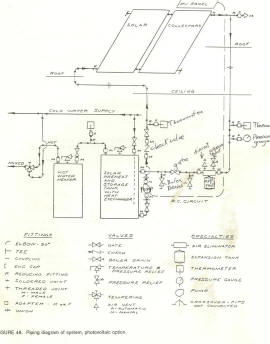
Doug
Nov 20, 2008
You can reach Doug at: dougkalmer AT gmail DOT com (replace
AT with @, and DOT with a period)
Bob's DIY Solar
Water Heater
My 17+ years of
success with solar hot water made my friend Bob want a similar system for his
new house. Through word of mouth, I heard about someone in Huntsville who had a
four panel solar system free for the removal.
It was installed in the early 80`s and heated domestic hot water, had fan coil
units for space heating, and heated an in ground pool. The systems installed
then used electronic controls to operate valves and pumps, commonly the controls
develop problems and parts and knowledgeable service techs are hard to find.
Bob and I spent a long hard day removing the panels, two 120 gallon tanks, three
heat exchangers, much copper piping, valves, pumps, etc. We planned on using the
components to assemble more modern systems using a Photovoltaic (PV) 12 volt
panel directly wired to a DC pump to eliminate the controls and use of external
electrical inputs- meaning stand alone systems using only solar energy to heat
and circulate a non-toxic antifreeze to the Heat Exchanger (HE). The HE then
uses only gravity to circulate tap water through it, heating the 120 gallons in
the insulated tank. This is called a closed loop, PV pumped solar hot water
system.
|
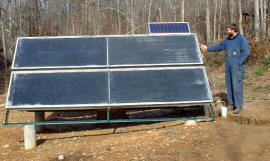
The two 40 sqft solar water heating collectors and
the PV panel that powers the pump.
The two collectors are connected in series.
I welded up the rack using 1" angle iron, my MIG running
from Bob`s generator. He has stand alone PV power,
and his system would not power the welder.
He poured the footers using tarpaper wrapped
into a cylinder for a form.
Click on pictures to enlarge |

PV panel and pump in housing.
Bob trenched and buried the lines to the house, first covering
them in insulation, then enclosing them in PVC pipe. |
There are two fluid loops:
In the collector loop, non-toxic antifreeze is pumped by the PV powered pump
through the collectors, then underground to the house and through the inner
tubes of the two heat exchangers, and then back to the collectors.
The pump used in this loop is a Hartell MD-10-HEH 12 volt, brushless magnetic
drive, PV direct.
An expansion tank is used to accommodate changes in the volume of the liquid in
the loop with temperature changes. Valves are provided to allow Bob to just
heat domestic water, or just flow the antifreeze through the PEX in the slab for
space heating, or to do both at once. In the storage tank loop, the
potable tank water in the heat exchanger is warmed by the collector water, and
rises up the pipe that enters the top of the storage tank. Cool water from the
bottom of the tank, being denser, flows by gravity
into the bottom of the heat exchanger to be warmed.
The circulation loop on the storage
tank side uses only natural convection to circulate the fluid. In order for
this to work well, the bottom of the tank must be elevated above the top of the
heat exchangers.
Bob has tubing running through the concrete slab of his home, he can have the
heated antifreeze either just heat domestic water, or the slab for space
heating, or both. That's why he's using two panels, one panel and a smaller tank
would be sufficient for just domestic hot water for families of up to five. Each
panel is nearly 40 square feet. Bob never soldered copper pipe before, but he
did a good job of reusing as much tubing as he could.
|

120 gallon storage tank.
Top of heat exchangers just visible.
Tank is elevated to allow thermosyphon circulation
of fluid in the tank circuit.
Click on pictures to enlarge |
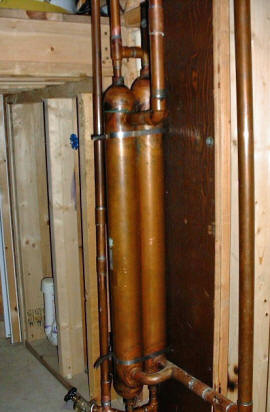
The two heat exchanger plumbed in parallel. |
All pictures are before Bob insulated all piping and the HE. Bob's main
expenses were for the 12v PV panel and pump. I used a 10 watt panel on my
similar system, Bob chose a 30, I feel this is larger and more expensive than
necessary. The pump is mounted close to the PV panel, Bob and I modified an ammo
box to house it. I built the rack to support the panels. This sort of reliable
system can be put together for considerably less cash than buying a complete
system, it just requires hard work and the willingness to learn. Free heat and
hot water from the sun!
Doug
Jan 13, 2008
You can reach Doug at:
dougkalmer AT gmail DOT com (replace AT with @, and DOT with a period)
| |
A small caution:
The heat exchangers in Bob's system are single wall heat exchangers.
This means that a leak in the heat exchanger wall can allow antifreeze
to enter the potable water stream. This makes it VERY important to
use non-toxic antifreeze in the system. Systems that use single
wall heat exchangers should have labels that explain to future owners
that non-toxic antifreeze must be used. Codes in some areas will
prohibit single wall heat exchangers even with non-toxic antifreeze.
Efficient double wall heat exchangers are available, and are not that
much more costly.
Gary |
Doug's Other Projects
Doug has contributed a number of
projects to Build-It-Solar covering a wide range of solar and
renewable energy areas --
see them all...
Thanks very much to Doug for
providing this material!



